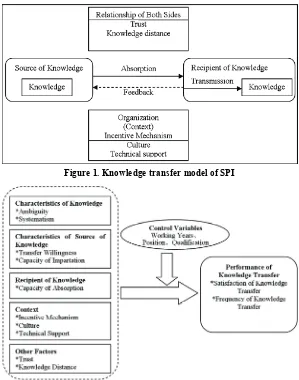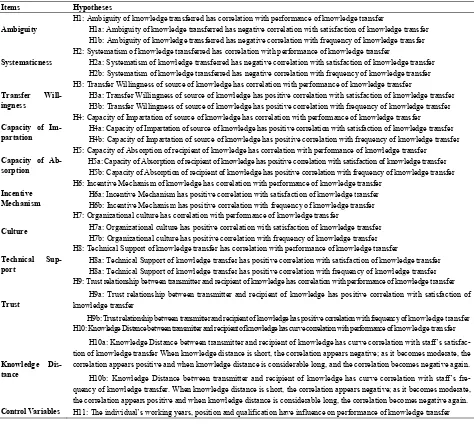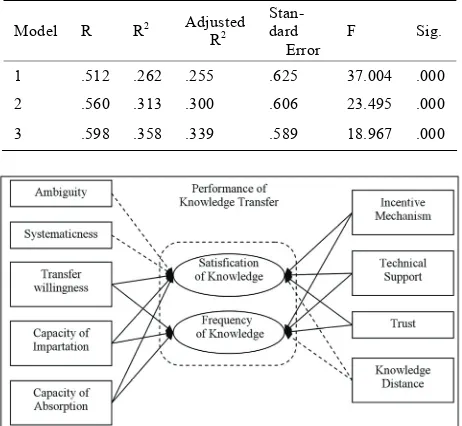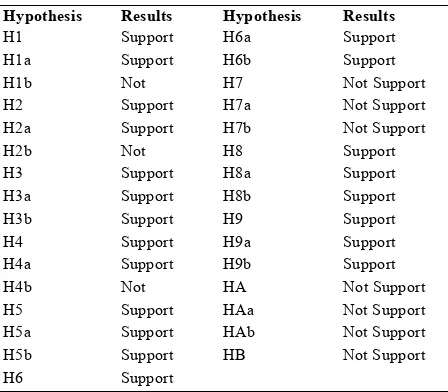doi:10.4236/jsea.2010.32017 Published Online February 2010 (http://www.SciRP.org/journal/jsea)
Research on Knowledge Transfer Influencing
Factors in Software Process Improvement
Jiangping Wan1,2, Qingjing Liu1, Dejie Li1, Hongbo Xu3,4
1School of Business Administration, South China University of Technology, Guangzhou, China; 2Institute of Emerging Industrializa-tion Development, South China University of Technology, Guangzhou, China; 3School of Computer Science and Engineering, South China University of Technology, Guangzhou, China; 4Guangzhou O-Engineer Information Technology Ltd, Guangzhou, China. Email: scutwjp@126.com, ruthy07@163.com, ab23456@163.com
Received October 28th, 2009; revised November 17th, 2009; accepted November 25th, 2009.
ABSTRACT
Knowledge transfer model of software process improvement (SPI) and the conceptual framework of influencing factors are established. The model includes five elements which are knowledge of transfer, sources of knowledge, recipients of knowledge, relationship of transfer parties, and the environment of transfer. The conceptual framework includes ten key factors which are ambiguity, systematism, transfer willingness, capacity of impartation, capacity of absorption, incen-tive mechanism, culture, technical support, trust and knowledge distance. The research hypotheses is put forward. Em-pirical study concludes that the trust relationship among SPI staffs has the greatest influence on knowledge transfer, and organizational incentive mechanism can produce positive effect to knowledge transfer of SPI. Finally, some sug-gestions are put forward to improve the knowledge transfer of SPI: establishing a rational incentive mechanism, exe-cuting some necessary training to transfer parties and using software benchmarking.
Keywords: Software Process Improvement, Knowledge Transfer, Influence Factors, Pattern
The software process is the set of tools, method, and practices we use to produce a software product. The objectives of software process improvement (SPI) are to process produce products according to plan while simultaneously improving the organization’s capability to produce better products [1]. The six basic principles of SPI by Watts S. Humphrey are as follows: 1) Major changes to the software process must start at the top; 2) Ultimately, everyone must be involved; 3) Effective change requires a goal and knowledge of the current process; 4) Change is continuous; 5) Software process changes will not be retained without conscious effort and periodic reinforcement; 6) Software process improve-ment requires investimprove-ment [1]. Alfonso Fuggetta argues that the scope of software improvement methods and models should be widened in order to consider all the different factors affecting software development activi-ties. We should reuse the experiences gained in other business domains and in organizational behavior research. Statistics is not the only source of knowledge. We should
also appreciate the value of qualitative observations [2]. Wan Jiangping argues that managers should think deeply into their think processes. The following issues in software organization can be resolved with SPI: 1) The processes and their principles for how to inherit and acquire others’ knowledge; 2) The processes and their principles for con-version knowledge into their capability [3]. Literature 6 describes a repository of 400 process improvement ex-periments and presents patterns that help organizations plan their improvement initiatives [4].
1. Introduction
1.1 Organization Knowledge in Software Process Improvement
Organizational knowledge creation is the process of making available and amplifying knowledge created by individuals as well as crystallizing and connecting it to an organization’s knowledge system [5]. Software or-ganization is a highly knowledge-intensive enterprise, knowledge transfer is critical for software enterprise. It is obvious that software process is also an organiza-tional knowledge intensive learning process and needed to be supported with knowledge management [6].
*This research was supported by Key Project of Guangdong Province
Sandra A. Slaughter and Laurie J. Kirsch conceptu-alize knowledge transfer portfolios in terms of their composition (the types of mechanisms used) and their intensity (the frequency with which the mechanisms are utilized). They hypothesize the influence of organ-izational design decisions on the composition and inten-sity of knowledge transfer portfolios for SPI. They then posit how the composition and intensity of knowledge transfer portfolios affect performance improvement. Their findings indicate that a more intense portfolio of knowledge transfer mechanisms is used when the source and recipient are proximate, when they are in a hierar-chical relationship, or when they work in different units [7]. Literature 8 includes: 1) A knowledge management framework for SPI; 2) An innovative knowledge model-ing and control approaches; 3) Minmodel-ing and retrieval ap-proaches on the software process assets; 4) A knowledge management for SPI.
1.2 Knowledge Transfer
Bloodgood considers knowledge transfer as knowledge transfer and transmit among various organizations and individual [9]. Argote considers enterprise knowledge transfer as a process that one organization’s experiences impact on other’s organizational action. It is that knowl-edge change or change knowlknowl-edge recipients’ behavior [10]. Davenport considers knowledge transfer as unified process which consists of both knowledge transfer proc-ess and knowledge absorbs procproc-ess [11]. The effective knowledge transfer is that transfer knowledge is reserved [12]. Ingram considers knowledge transfer as process sharing knowledge in organization through various chan-nels in order to make use of extant knowledge effectively [13]. Dong-Gil Ko et al. consider knowledge transfer as transmitting process in which knowledge transfer from owners to recipients for their learning and application [14].
In our understanding, knowledge transfer includes three aspects which are the process spreading from own-ers to recipients, activities occurring under contextualiza-tion and special goal. But the ultimate goal is to make the knowledge of the owners be the recipients’ and narrow the knowledge gap between owners and recipients so as to promote the co-development of individuals and or-ganizations. We define knowledge transfer as the process making knowledge transferring from the source of knowledge to recipients in contextualization.
1.3 Knowledge Transfer Model
The knowledge transfer model mainly includes process model and factors model. The process model is a model dividing knowledge transfer into different stages. The representative process models are Nonaka knowledge spiral model [15], Szulanski four stages model [12], and Gilbert&Cordey-Hayes five steps model. While factors model bases on factors in the process the knowledge
transfer [16]. The representative ones of it are the four factors model invented by Jeffrey L. Cummings and Bing-Sheng Teng which includes sources of the knowl-edge, recipients of the knowlknowl-edge, knowledge and con-text and transfer framework invented by Vito Albino et al. including transfer subject, context, content, and trans-fer media. Jeffrey L. Cummings and Bing-Sheng Teng’s factors model is applied in this study [17].
1.4 Knowledge Transfer Influencing Factors
Knowledge transfer influencing factors are in the fol-lowing [18]: 1) Characteristics of knowledge transferred include causal ambiguity and unprovability. 2) Charac-teristics of source of knowledge include knowledge pro-viders shortage of motivation to transfer knowledge and unbelieving. The knowledge owners will not sharing knowledge with others because they are afraid losing knowledge possession, superiority complex, right and status and so on, lack time to sharing knowledge with others and couldn’t proper reward and return on knowl-edge sharing. When the experts are not discovered and believed, their suggestions may be rejected and more challenged. 3) Characteristics of recipient of knowledge include knowledge recipients’ both absorbing capability and keeping capability. It is very important for the knowledge recipient’s capability to absorb others’ knowledge and integrate into individual knowledge on the condition he will accept the knowledge developed by other. 4) Characteristics of context include barren organ-izational context and arduous relationship. Both will im-part on knowledge transfer.
2. Research Model and Hypotheses
Figure 1. Knowledge transfer model of SPI
Figure 2. Conceptual framework of influencing factors
support, trust and knowledge distance (Figure 2). Then we propose our research hypotheses based on knowl-edge transfer model and conceptual framework of knowledge transfer influencing factors (Table 1).
3. Research Design
3.1 Scale Design
We studied the variable indicators on a five-point Likert-type scale. The questionnaire of pre-investigation was divided into four parts. The first part was ques-tionnaire direction, including quesques-tionnaire background and introduction of basic information. The second part was the basic information of respondents, including gen-der, age and qualifications of respondents; the third part was the main body of the questionnaire, mainly about the issues of influence factors, including a total of 46 items. The last part with regard to performance of knowledge transfer involved a total of 4 items. After the completion of the pre-prepared questionnaire, we pre-prepared ques-tionnaire in a small number of target groups by e-mail.
We issued 10 questionnaires and six were received. In the end, we received a total of 114 questionnaires, of which eight were invalid, 106 were valid.
3.2 Data Collection
Table 1. Research hypotheses
Items Hypotheses
H1: Ambiguity of knowledge transferred has correlation with performance of knowledge transfer
H1a: Ambiguity of knowledge transferred has negative correlation with satisfaction of knowledge transfer Ambiguity
H1b: Ambiguity of knowledge transferred has negative correlation with frequency of knowledge transfer H2: Systematism of knowledge transferred has correlation with performance of knowledge transfer
H2a: Systematism of knowledge transferred has negative correlation with satisfaction of knowledge transfer Systematicness
H2b: Systematism of knowledge transferred has negative correlation with frequency of knowledge transfer H3: Transfer Willingness of source of knowledge has correlation with performance of knowledge transfer
H3a: Transfer Willingness of source of knowledge has positive correlation with satisfaction of knowledge transfer Transfer
Will-ingness H3b: Transfer Willingness of source of knowledge has positive correlation with frequency of knowledge transfer
H4: Capacity of Impartation of source of knowledge has correlation with performance of knowledge transfer H4a: Capacity of Impartation of source of knowledge has positive correlation with satisfaction of knowledge transfer Capacity of
Im-partation H4b: Capacity of Impartation of source of knowledge has positive correlation with frequency of knowledge transfer
H5: Capacity of Absorption of recipient of knowledge has correlation with performance of knowledge transfer H5a: Capacity of Absorption of recipient of knowledge has positive correlation with satisfaction of knowledge transfer Capacity of
Ab-sorption H5b: Capacity of Absorption of recipient of knowledge has positive correlation with frequency of knowledge transfer
H6: Incentive Mechanism of knowledge has correlation with performance of knowledge transfer H6a: Incentive Mechanism has positive correlation with satisfaction of knowledge transfer Incentive
Mechanism H6b: Incentive Mechanism has positive correlation with frequency of knowledge transfer
H7: Organizational culture has correlation with performance of knowledge transfer
H7a: Organizational culture has positive correlation with satisfaction of knowledge transfer Culture
H7b: Organizational culture has positive correlation with frequency of knowledge transfer H8: Technical Support of knowledge transfer has correlation with performance of knowledge transfer
H8a: Technical Support of knowledge transfer has positive correlation with satisfaction of knowledge transfer Technical
Sup-port H8a: Technical Support of knowledge transfer has positive correlation with frequency of knowledge transfer H9: Trust relationship between transmitter and recipient of knowledge has correlation with performance of knowledge transfer
H9a: Trust relationship between transmitter and recipient of knowledge has positive correlation with satisfaction of knowledge transfer
Trust
H9b: Trust relationship between transmitter and recipient of knowledge has positive correlation with frequency of knowledge transfer H10: Knowledge Distance between transmitter and recipient of knowledge has curve correlation with performance of knowledge transfer
H10a: Knowledge Distance between transmitter and recipient of knowledge has curve correlation with staff’s satisfac-tion of knowledge transfer When knowledge distance is short, the correlasatisfac-tion appears negative; as it becomes moderate, the correlation appears positive and when knowledge distance is considerable long, and the correlation becomes negative again. Knowledge
Dis-tance H10b: Knowledge Distance between transmitter and recipient of knowledge has curve correlation with staff’s
fre-quency of knowledge transfer. When knowledge distance is short, the correlation appears negative; as it becomes moderate, the correlation appears positive and when knowledge distance is considerable long, the correlation becomes negative again. Control Variables H11: The individual’s working years, position and qualification have influence on performance of knowledge transfer
3.3 Result Analysis and Explanation
3.3.1 Statistical Result Analysis
In order to ensure the scientific nature of the proposition certification, it is necessary to test the reliability and va-lidity of the measure model. First, all variables’ Cron-bach’s coefficient are significantly higher than the mini-mum threshold 0.70, factor analysis and confirmatory factor analysis are all met reference standards, so we can judge it has internal validity. Second, for all indicators, standardized loading factors are also higher than that of the recommended minimum critical level 0.50, the statis-tical value of Battelle is a much smaller than 0.01. All of these indicate that all scales have highly convergent va-lidity. The above shows that the research ha good exter-nal validity. Integrated the test of reliability and validity,
the scales are reliable and effective which can be used to verify model assumptions.
transfer influence factors as independent variables, and executed regression analysis by step regression method when considering the causal relationship among knowl-edge transfer performance and its influence factors. The results are in Table 3.
[image:5.595.58.286.297.459.2]From the overall regression effect with F=18.967, P= 0.000, regression equation has achieved a very signifi-cant level which indicates better regression effect. Meanwhile, variance expansion factor VIF had small value and multiple co-linear problems were not obvious. The adjusted determination coefficient is 0.339 indi-cating that three indicators of knowledge transfer influ-ence can explain 33.9% of the total variance. The coeffi-cient values of constant and variables are all less than 0.05 suggesting that they have significant meaning.
Table 2. Correlation analysis between influencing factors and performance of knowledge transfer
Performance of Knowl-edge Transfer
Performance
Influencing Factors
Correlation Sig.
L1 Ambiguity -.143* .000
L2 Systematism -.109** .000
L3 Transfer Willingness .375** .000
L4 Capacity of Impartation .285* .0016
L5 Capacity of Absorption .392** .000
L6 Incentive Mechanism .387** .009
L7 Culture 213 .159
[image:5.595.57.289.479.695.2]L8 Trust .558** .000
Table 3. Overall effect parameter by step regression
Model R R2 Adjusted
R2
Stan-dard
Error
F Sig.
1 .512 .262 .255 .625 37.004 .000
2 .560 .313 .300 .606 23.495 .000
3 .598 .358 .339 .589 18.967 .000
Figure 3. Influencing relationship of performance of knowledge transfer in software process
In order to clear the influence factors and their direc-tion of the performance of knowledge transfer in SPI, we employed Figure 3 to express test results of Table 4 where the line indicated positive relationship and the dotted line negative relationship. From Table 4 and Fig-ure 3, we can conclude that the majority results of em-pirical research are consistent with our hypotheses and they are listed as follows: In the characteristics of knowledge, the ambiguity impacting on the performance of knowledge transfer mainly manifested on the satisfac-tion of transfer. The more ambiguous the source of knowledge is, the more time and energy will be spending when we express the knowledge out from source of knowledge. The systematization of knowledge impacting on the performance of knowledge transfer mainly indi-cates that it has a negative effect on the performance of knowledge transfer. The higher the systematism of know- ledge is, the more difficult for transmitter of knowledge to express real meaning of the knowledge.
3.3.2 Empirical Result Analysis
According to the above statistical results, the test results of our hypotheses were concluded in Table 4.
In the characteristics of source knowledge, the transfer willingness of knowledge has significantly positive cor-relation to the satisfaction and frequency of knowledge transfer. In the characteristics of recipients of knowledge, the recipients’ capacity of absorption has significantly positive influence on the effect of knowledge transfer.
In the environmental factors of knowledge transfer in SPI, the incentive mechanism has significantly positive influence on the satisfaction and frequency of knowledge transfer. The employees of the organization will retain their knowledge because they are worried about losing their authority when imparting their knowledge to others, if the organization does not take certain incentives.
In the relationship between source of knowledge and recipient of knowledge, trust relationship has the largest impact on the performance of knowledge transfer of all influence factors. This shows that trust relationship be-tween source of knowledge and recipient of knowledge is the most basic factor of knowledge transfer in SPI. The curve relationship between knowledge distance and the performance of knowledge transfer is not obvious.
4. Management Enlightment and Suggestion
In order to improve the staffs’ performance of SPI in practice, the following three aspects are necessary.
[image:5.595.57.288.479.692.2]Table 4. Test results of hypotheses (a=10, b=11)
Hypothesis Results Hypothesis Results
H1 Support H6a Support
H1a Support H6b Support
H1b Not H7 Not Support
H2 Support H7a Not Support
H2a Support H7b Not Support
H2b Not H8 Support
H3 Support H8a Support
H3a Support H8b Support
H3b Support H9 Support
H4 Support H9a Support
H4a Support H9b Support
H4b Not HA Not Support
H5 Support HAa Not Support
H5a Support HAb Not Support
H5b Support HB Not Support
H6 Support
or mental compensation and think highly of achieve-ment of source of knowledge. Similarly, recipient of knowledge also need some encouragement to accept and use new knowledge. It can make the two sides of knowl-edge transfer participate actively by sharing their inter-ests and therefore promote organizational SPI.
2) Carrying out necessary training for the both sides of knowledge transfer. After solving the transfer willingness of the two sides, the transfer capacity of source of knowledge, capacity of absorption of recipient of knowledge and distance between source of knowledge and recipient of knowledge have greater influence on knowledge transfer. Thus, software organizations need to give corresponding training for both of the two parties. They can employ external experts to train their staffs so that the staffs’ capacity of imparting knowledge can gain improvement.
3) Using software benchmarking [19]. In pursuit of a capability model rating, software benchmarking (in our understanding, the benchmarking is standard best knowledge patterns, such as CMMI and SWEBOK [20], etc.) would help its process improvement and assessment effort. This benchmarking questionnaire can be grouped into five categories: a) Philosophy of implementa-tion—how each company achieved CMMI compliance in terms of schedule, teams, and planning. b) Management commitment—the strength of institutional support for the process improvement effort. c) Cultural change and in-stitutionalization—issues that arose regarding acceptance of the new process philosophy. d) Definition of organiza-tion—because the CMMI assessment is for specific or-ganizations, these questions assessed the scope of their effort (for example, a section, company, or corporation). e) Objective evidence—the CMMI assessment process requires objective evidence that the new process is being followed, so these questions probed how each company
collected evidence.
5. Conclusions
In this study, the knowledge transfer model of SPI and the conceptual framework of 10 key influence factors are es-tablished. Then research hypotheses are put forward. Em-pirical study concludes that the trust relationship among SPI staffs has the greatest influence on knowledge transfer, and organizational incentive mechanism can produce posi-tive effect to knowledge transfer of SPI. We believed that the research is helpful for SPI practitioners to improve their performance of knowledge transfer.
6. Acknowledgements
Thanks for helpful discussion with Mr. Hou Yawen, Mr. Zhou qiyang, Mr. Li Jiangzhang, Mr. Nihao, Mr. Zhou Zhijun, and the hard work of my student Zeng Yonghua and Zheng Chuwei.
REFERENCES
[1] W. S. Humphrey, “Managing the software process,” Reading, Addison-Wesley, MA, 1989.
[2] Alfonso Fuggetta, “Software process: A roadmap,” Pro-ceedings of the Conference on The Future of Software Engineering, Limerick, Ireland, pp. 25–34, June 04–11, 2000.
[3] J. P. Wan and J. M. Yang, “Knowledge management in SPI,” Application Research of Computer, Vol. 19, No. 5, pp. 1–3, 2002.
[4] M. Blanco, P. Gutiérrez, and G. Satriani, “SPI patterns: Learning from experience,” IEEE Software, Vol. 18, No. 3, pp. 28–35, 2001.
[5] I. Nonaka and G.g von Krogh, “Perspective-tacit knowl-edge and knowlknowl-edge conversion: Controversy and ad-vancement in organizational knowledge creation theory,” Organization Science, Vol. 20, No. 3, pp. 635–652, 2009. [6] J. P. Wan, “Research on software product support
struc-ture,” Journal of Software Engineering and Applications, Vol. 2, No. 3, pp. 174–194, 2009.
[7] S. A. Slaughter and L. J. Kirsch, “The effectiveness of knowledge transfer portfolios in SPI: A field study,” In-formation Systems Research, September 2006.
[8] X. G. Zhang, “Research on knowledge management technology in SPI,” Chinese Academy of Sciences Doc-toral Thesis, 2004.
[9] J. M. Bloodgood and W. D. Salisbury, “Understanding the influence of organizational change strategies on in-formation technology and knowledge management strate-gies,” Decision Support Systems, Vol. 31, No. 1, pp. 55–69, 2001.
[10] L. Argote, “Organizational learning: Creating, retaining and transfering knowledge,” Kluwer Academic Publishers, pp. 143–189, 1999.
How organization manage what they know,” Harvard Business School Press, Boston, 1998.
[12] G. Szulanzki, “Exploring internal stickiness: Impediments to the transfer of best practice with the firm,” Strategic Management Journal, Vol. 17, pp. 27–43, 1996.
[13] L. Argote and P. Ingram, “Knowledge transfer: A basis for competitive advantage in firms,” Organizational Be-havior and Human Decision Processes, Vol. 82, No. 1, pp. 150–169, 2000.
[14] D.-G. Ko, L. J. Kirsch, and W. R. King, “Antecedents of knowledge transfer from consultants to clients in enter-prise system implementations,” Management Information System Quarterly (Special Issue), Vol. 29, No. 1, pp. 59– 85, 2005.
[15] I. Nonaka and H. Takeuchi, “The knowledge creating company,” Oxford University Press, New York, 1995. [16] M. Gilbert and M. Cordey-Hayes, “Understanding the
process of knowledge transfer to achieve successful technological innovation,” Technovation, Vol. 16, pp. 301–312, 1996.
[17] J. L. Cummings and B. S. Teng, “Transferring R & D knowledge: The key factors affecting knowledge transfer success,” Journal of Engineering and Technology Man-agement, Vol. 20, pp. 39–68, 2003.
[18] M. Polanyi, “The study of man,” Routledge & Kegan, London, Vol. 12, 1957.
[19] G. C. Thomas and H. R. Smith, “Using structured bench- marking to fast-track CMM process improvement,” IEEE Software, Vol. 18, No. 5, pp. 48–52, 2001.



